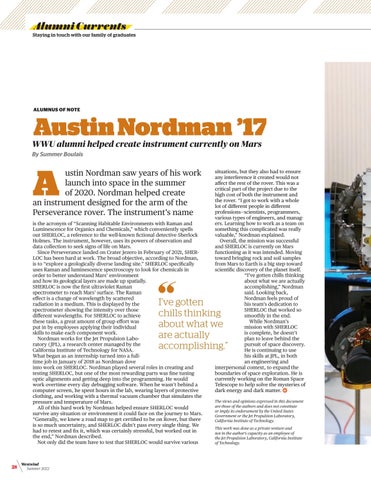Alumni Currents
Staying in touch with our family of graduates
ALUMNUS OF NOTE
Austin Nordman ’17
WWU alumni helped create instrument currently on Mars By Summer Boulais
A
ustin Nordman saw years of his work launch into space in the summer of 2020. Nordman helped create an instrument designed for the arm of the Perseverance rover. The instrument’s name is the acronym of “Scanning Habitable Environments with Raman and Luminescence for Organics and Chemicals,” which conveniently spells out SHERLOC, a reference to the well-known fictional detective Sherlock Holmes. The instrument, however, uses its powers of observation and data collection to seek signs of life on Mars. Since Perseverance landed on Crater Jezero in February of 2021, SHERLOC has been hard at work. The broad objective, according to Nordman, is to “explore a geologically diverse landing site.” SHERLOC specifically uses Raman and luminescence spectroscopy to look for chemicals in order to better understand Mars’ environment and how its geological layers are made up spatially. SHERLOC is now the first ultraviolet Raman spectrometer to reach Mars’ surface. The Raman effect is a change of wavelength by scattered radiation in a medium. This is displayed by the spectrometer showing the intensity over those different wavelengths. For SHERLOC to achieve these tasks, a great amount of group effort was put in by employees applying their individual skills to make each component work. Nordman works for the Jet Propulsion Laboratory ( JPL), a research center managed by the California Institute of Technology for NASA. What began as an internship turned into a fulltime job in January of 2018 as Nordman dove into work on SHERLOC. Nordman played several roles in creating and testing SHERLOC, but one of the most rewarding parts was fine tuning optic alignments and getting deep into the programming. He would work overtime every day debugging software. When he wasn’t behind a computer screen, he spent hours in the lab, wearing layers of protective clothing, and working with a thermal vacuum chamber that simulates the pressure and temperature of Mars. All of this hard work by Nordman helped ensure SHERLOC would survive any situation or environment it could face on the journey to Mars. “Generally, we knew a road map to get certified to be on Rover, but there is so much uncertainty, and SHERLOC didn’t pass every single thing. We had to retest and fix it, which was certainly stressful, but worked out in the end,” Nordman described. Not only did the team have to test that SHERLOC would survive various
situations, but they also had to ensure any interference it created would not affect the rest of the rover. This was a critical part of the project due to the high cost of both the instrument and the rover. “I got to work with a whole lot of different people in different professions—scientists, programmers, various types of engineers, and managers. Learning how to work as a team on something this complicated was really valuable,” Nordman explained. Overall, the mission was successful and SHERLOC is currently on Mars functioning as it was intended. Moving toward bringing rock and soil samples from Mars to Earth is a big step toward scientific discovery of the planet itself. “I’ve gotten chills thinking about what we are actually accomplishing,” Nordman said. Looking back, Nordman feels proud of his team’s dedication to SHERLOC that worked so smoothly in the end. While Nordman’s mission with SHERLOC is complete, he doesn’t plan to leave behind the pursuit of space discovery. He is continuing to use his skills at JPL, in both an engineering and interpersonal context, to expand the boundaries of space exploration. He is currently working on the Roman Space Telescope to help solve the mysteries of dark energy and dark matter.
I’ve gotten chills thinking about what we are actually accomplishing.”
28
Westwind Summer 2022
The views and opinions expressed in this document are those of the authors and does not constitute or imply its endorsement by the United States Government or the Jet Propulsion Laboratory, California Institute of Technology. This work was done as a private venture and not in the author’s capacity as an employee of the Jet Propulsion Laboratory, California Institute of Technology.
